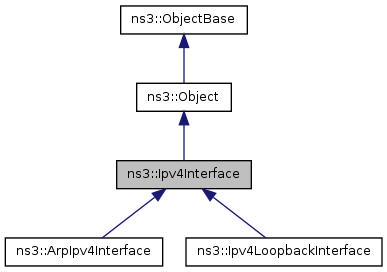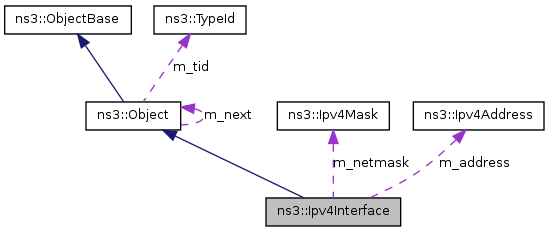The IPv4 representation of a network interface. More...
#include <ipv4-interface.h>


Public Member Functions | |
| virtual Ptr< NetDevice > | GetDevice (void) const =0 |
| void | SetAddress (Ipv4Address a) |
| void | SetNetworkMask (Ipv4Mask mask) |
| Ipv4Address | GetBroadcast (void) const |
| Ipv4Mask | GetNetworkMask (void) const |
| void | SetMetric (uint16_t metric) |
| uint16_t | GetMetric (void) const |
| Ipv4Address | GetAddress (void) const |
| uint16_t | GetMtu (void) const |
| bool | IsUp (void) const |
| bool | IsDown (void) const |
| void | SetUp (void) |
| void | SetDown (void) |
| void | Send (Ptr< Packet > p, Ipv4Address dest) |
Static Public Member Functions | |
| static TypeId | GetTypeId (void) |
| This method returns the TypeId associated to ns3::Ipv4Interface. | |
Protected Member Functions | |
| virtual void | DoDispose (void) |
Detailed Description
The IPv4 representation of a network interface.
This class roughly corresponds to the struct in_device of Linux; the main purpose is to provide address-family specific information (addresses) about an interface.
This class defines two APIs:
- the public API which is expected to be used by both the IPv4 layer and the user during forwarding and configuration.
- the private API which is expected to be implemented by subclasses of this base class. One such subclass will be a Loopback interface which loops every packet sent back to the ipv4 layer. Another such subclass typically contains the Ipv4 <-> MAC address translation logic which will use most of the time the ARP/RARP protocols.
By default, Ipv4 interface are created in the "down" state with ip address 192.168.0.1 and a matching mask. Before becoming useable, the user must invoke SetUp on them once the final Ipv4 address and mask has been set.
Subclasses must implement the two methods:
- Ipv4Interface::SendTo
- Ipv4Interface::GetDevice
Member Function Documentation
| virtual void ns3::Ipv4Interface::DoDispose | ( | void | ) | [protected, virtual] |
This method is called by Object::Dispose or by the object's destructor, whichever comes first.
Subclasses are expected to implement their real destruction code in an overriden version of this method and chain up to their parent's implementation once they are done. i.e., for simplicity, the destructor of every subclass should be empty and its content should be moved to the associated DoDispose method.
Reimplemented from ns3::Object.
Reimplemented in ns3::ArpIpv4Interface.
| Ipv4Address ns3::Ipv4Interface::GetAddress | ( | void | ) | const |
- Returns:
- the ipv4 address of this interface
| Ipv4Address ns3::Ipv4Interface::GetBroadcast | ( | void | ) | const |
- Returns:
- the broadcast ipv4 address associated to this interface
- Returns:
- the underlying NetDevice. This method can return zero if this interface has no associated NetDevice.
Implemented in ns3::ArpIpv4Interface, and ns3::Ipv4LoopbackInterface.
| uint16_t ns3::Ipv4Interface::GetMetric | ( | void | ) | const |
- Returns:
- configured routing metric (cost) of this interface
| uint16_t ns3::Ipv4Interface::GetMtu | ( | void | ) | const |
This function a pass-through to NetDevice GetMtu, modulo the LLC/SNAP header i.e., ipv4MTU = NetDeviceMtu - LLCSNAPSIZE
- Returns:
- the Maximum Transmission Unit associated to this interface.
| Ipv4Mask ns3::Ipv4Interface::GetNetworkMask | ( | void | ) | const |
- Returns:
- the ipv4 netmask of this interface
| static TypeId ns3::Ipv4Interface::GetTypeId | ( | void | ) | [static] |
This method returns the TypeId associated to ns3::Ipv4Interface.
This object is accessible through the following paths with Config::Set and Config::Connect:
- /NodeList/[i]/$ns3Ipv4L3Protocol/InterfaceList/[i]
No Attributes defined for this type.
No TraceSources defined for this type.
Reimplemented from ns3::Object.
Reimplemented in ns3::ArpIpv4Interface, and ns3::Ipv4LoopbackInterface.
| bool ns3::Ipv4Interface::IsDown | ( | void | ) | const |
- Returns:
- true if this interface is disabled, false otherwise.
| bool ns3::Ipv4Interface::IsUp | ( | void | ) | const |
These are IP interface states and may be distinct from NetDevice states, such as found in real implementations (where the device may be down but IP interface state is still up).
- Returns:
- true if this interface is enabled, false otherwise.
| void ns3::Ipv4Interface::Send | ( | Ptr< Packet > | p, | |
| Ipv4Address | dest | |||
| ) |
- Parameters:
-
p packet to send dest next hop address of packet.
This method will eventually call the private SendTo method which must be implemented by subclasses.
| void ns3::Ipv4Interface::SetAddress | ( | Ipv4Address | a | ) |
- Parameters:
-
a set the ipv4 address of this interface.
| void ns3::Ipv4Interface::SetDown | ( | void | ) |
Disable this interface
| void ns3::Ipv4Interface::SetMetric | ( | uint16_t | metric | ) |
- Parameters:
-
metric configured routing metric (cost) of this interface
| void ns3::Ipv4Interface::SetNetworkMask | ( | Ipv4Mask | mask | ) |
- Parameters:
-
mask set the ipv4 netmask of this interface.
| void ns3::Ipv4Interface::SetUp | ( | void | ) |
Enable this interface
The documentation for this class was generated from the following files:
- src/internet-stack/ipv4-interface.h
- doc/introspected-doxygen.h
 1.7.1
1.7.1